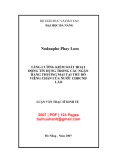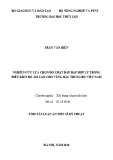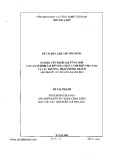EURASIP Journal on Applied Signal Processing 2004:9, 1257–1265 c(cid:1) 2004 Hindawi Publishing Corporation
Optimal STBC Precoding with Channel Covariance Feedback for Minimum Error Probability
Yi Zhao Department of Electrical and Computer Engineering, University of Toronto, 10 King’s College Road, Toronto, ON, Canada M5S 3G4 Email: zhaoyi@comm.utoronto.ca
Raviraj Adve Department of Electrical and Computer Engineering, University of Toronto, 10 King’s College Road, Toronto, ON, Canada M5S 3G4 Email: rsadve@comm.utoronto.ca
Teng Joon Lim Department of Electrical and Computer Engineering, University of Toronto, 10 King’s College Road, Toronto, ON, Canada M5S 3G4 Email: limtj@comm.utoronto.ca
Received 31 May 2003; Revised 15 January 2004
This paper develops the optimal linear transformation (or precoding) of orthogonal space-time block codes (STBC) for minimiz- ing probability of decoding error, when the channel covariance matrix is available at the transmitter. We build on recent work that stated the performance criterion without solving for the transformation. In this paper, we provide a water-filling solution for multi-input single-output (MISO) systems, and present a numerical solution for multi-input multi-output (MIMO) systems. Our results confirm that eigen-beamforming is optimal at low SNR or highly correlated channels, and full diversity is optimal at high SNR or weakly correlated channels, in terms of error probability. This conclusion is similar to one reached recently from the capacity-achieving viewpoint.
Keywords and phrases: MIMO, space-time block coding, beamforming, linear precoding.
1. INTRODUCTION
El Gamal [4, Proposition 7], who proved that with spatial correlation and quasistatic flat fading, full-diversity space- time codes such as orthogonal space-time block codes (OS- TBC) extract the maximum diversity gain achievable, with- out CSI at the transmitter.
In wireless communications, the adverse effects of channel fading can be mitigated by transmission over a diversity of independent channels. A large, and growing, body of re- sults have firmly established the potential of space-time cod- ing [1, 2, 3] in multi-input multi-output (MIMO) systems, which use antenna arrays at the transmitter and the receiver to provide spatial diversity at both ends of a communications link.
While spatial correlation does not affect diversity gain, Shiu and Foschini showed that correlation between spatial channels leads to a loss in capacity [5]. It is also known that spatial correlation results in a smaller coding advantage [2, Section II-C]. This paper explores practical approaches to recover this performance loss. However, given that nothing can improve the performance of current state-of-the-art full- diversity space-time codes without CSI at the transmitter, it is natural to consider performance improvements when this assumption is relaxed.
In [3], Tarokh et al. introduced the well-known rank and determinant criteria for the design of space-time codes without channel knowledge at the transmitter. Furthermore, it was argued [2, Section II-C] that these criteria apply to both spatially independent and dependent fading channels. In other words, without channel state information (CSI) at the transmitter, space-time codes should be designed us- ing the rank and determinant criteria, even when the spa- tial channels are correlated. This result was confirmed by In this paper, we study the design of a linear precoder for OSTBC in spatially correlated, quasistatic, flat fading channels with knowledge of the channel covariance at the transmitter. The objective is to minimize the probability of
Data
Demodulator
Data
STBC decoder
Modulator
STBC encoder
Linear transformation
.. .
.. .
.. .
.. .
N antennae ...
M antennae .. .
. . .
Correlation
CSI
CSI and correlation estimator
1258 EURASIP Journal on Applied Signal Processing
Figure 1: Precoded STBC transmitter and receiver block diagrams.
wise error probability (PEP) between codewords in corre- lated fading. An ML receiver is used. Illustrations of the transmitter and receiver for such a system are shown in Figure 1.
The MIMO channel between the transmitter and the re- ceiver, assumed flat and Rayleigh, is described by the N × M matrix
, H = (1) . .. ... h11 h12 · · · h1M h21 h22 · · · h2M ... ... hN1 hN2 · · · hNM
(cid:7)
†(cid:8)
where the element hnm is the fading coefficient between the mth transmit antenna and the nth receive antenna. The chan- nel correlation matrix is
R = E hh , (2) h = vec(H),
decoding error. The channel covariance information may be fed back from the receiver. Such a system may be considered more practical than the case when true CSI is available at the transmitter, because in that case the feedback channel may be too heavy an overhead on the communication system. Prior work done on this topic developed the optimality criterion [6] to be satisfied by the precoding matrix, but no closed- form or numerical solution was provided. In this paper, a numerical solution is provided for MIMO systems with an arbitrary number of transmit and receive antennae. Further- more, we derive an exact water-filling solution for MISO sys- tems. Assuming uncorrelated fading at the receiver as in [7], we show that this solution is exact in MIMO systems as well. This problem setting ties in with recent work on de- termining the capacity-achieving signal correlation matrix when the channel covariance matrix is available at the trans- mitter [7, 8, 9]. In contrast, our research is focused on min- imizing the error probability, given a linear precoding struc- ture based on orthogonal STBC. Because of the orthogonal structure of the code matrices used, this transmitter has com- plexity only linear in the number of transmit antennas de- spite the use of a maximum-likelihood (ML) receiver [10].
where (·)† denotes Hermitian transpose, and vec(·) denotes the vectorization operator which stacks the columns of H. Note that this definition is identical to the one in [3].
The STBC encoder organizes data into an M ×L matrix C and successive columns of this matrix are transmitted over L time indices. The corresponding N ×L received signal matrix X can be written as The rest of the paper is organized as follows. Section 2 presents the background material needed in the rest of the paper, Section 3 discusses the optimal precoding under var- ious scenarios, while Section 4 introduces three simplified strategies that are shown to result in minimal performance loss. Simulation examples are presented in Section 5. Finally, Section 6 presents conclusions. X = HWC + E, (3)
2. BACKGROUND
(cid:2)X − HWC(cid:2)2 F,
where E is an N × L matrix with i.i.d. complex Gaussian ele- ments representing additive thermal noise. The receiver em- ploys an ML decoder, thus the decoded codeword (cid:9)C can be expressed as
(4) Consider a MIMO system with M transmit and N receive antennae. OSTBC is used, and a linear transformation unit is applied prior to transmission to take account of the chan- nel covariance information. The transformation matrix W ∈ CM×M is to be determined to minimize the maximum pair-
(cid:9)C = arg min C
STBC Precoding Based on Channel Covariance Feedback 1259
(cid:7)
(cid:8)
then
(cid:7)
(cid:11)
(cid:10)
(cid:11)(cid:8)
⊗
det
= det
(cid:15)
where (cid:2) · (cid:2)F is the Frobenius norm [11]. Note that, because HW is equivalent to a modified channel matrix ˜H, ML de- coding of C requires only the simple linear operation de- scribed in [10].
R ⊗ R−1 T (cid:10) URΛ−1 (cid:10)
† R U R (cid:11)(cid:10)
† T U T (cid:11)(cid:10)
(cid:11)†
= det
(cid:11)(cid:14)(cid:10)
= det
(cid:7)
(cid:8)
UR ⊗ UT (I ⊗ Z)η + R−1 (I ⊗ Z)η + (cid:14) (I ⊗ Z)η + (cid:14)(cid:10) UR ⊗ UT (cid:11) Λ−1 (cid:11)† UR ⊗ UT UR ⊗ UT (I ⊗ Zη) (cid:15)(cid:10) UT Λ−1 R ⊗ Λ−1 T (cid:10) UR ⊗ UT (cid:15) (cid:11)†
R ⊗ Λ−1 T (cid:11)
(cid:11)
= det
(cid:8)
R ⊗ U−1 T
(cid:7)
(cid:7)(cid:10)
(cid:8)
+ Λ−1 (cid:7)(cid:10) UR ⊗ UT det It is known that the exact probability of error is hard to compute, so in much of the literature (see e.g. [6]), we work with the maximum PEP, which is the dominating term of the probability of error, and try to minimize a bound on it. This approach was taken in [6] and the result is that the tight up- per bound on the Gaussian tail for the maximum PEP is min- imized by a transformation matrix W that satisfies UR ⊗ UT (cid:10) † T ZηUT U (cid:7) (cid:8) U−1 det Zopt = WoptW
† ⊗ RIUR U + Λ−1 R ⊗ Λ−1 T (cid:8) R ⊗ Λ−1 T
= det
IN ⊗ B + Λ−1 , (5)
(cid:11) η + R−1 IN ⊗ Z
, det (10)
† opt = arg max Z(cid:3)0, tr(Z)=M
† T ZηUT . The intermediate steps above come
(cid:18)
(cid:16) N(cid:17)
(cid:16) N(cid:17)
N(cid:17)
⊗
=
where B = U from the fact that [13] (cid:18)
i=1
i=1
i=1
(cid:11)(cid:10)
(cid:11)†
Ai Bi Ai ⊗ Bi, (11) where Z has to be positive semidefinite because Z = WW†, and the trace constraint is necessary to avoid power amplifi- cation. ⊗ denotes the Kronecker product, while η = µmin/4σ 2 with
(cid:12) µklI =
and det[UR ⊗ UT ] = 1. The trace constraint becomes
(cid:10) Ck − Cl
(cid:13) ,
(cid:10)
(cid:11)
(cid:11)
(cid:10)
Ck − Cl (6) µmin = arg minµkl
(12)
† T ZηUT tr(B) = tr U † T Zη = tr UT U = tr(Zη) = ηM,
among all possible codewords. In this paper, we follow this approach as well and solve the optimization problem defined in (5).
(cid:7)(cid:10)
(cid:8)
R ⊗ Λ−1 T
since tr(AB) = tr(BA). 3. OPTIMAL TRANSFORMATION The problem therefore reduces to finding a positive semidefinite matrix 3.1. General solution .
(cid:11) IN ⊗ B
T and Λ−1
det + Λ−1 (13) Bopt = arg max B(cid:3)0, tr(B)=ηM
R are both diagonal, B must be also di- agonal [14]. Let the ith diagonal element of ΛT and B, and the jth diagonal elements of ΛR be λti, bi, and λr j, respec- tively. The problem (8) becomes finding a set of nonnegative bi’s to maximize
Since Λ−1
M(cid:17)
N(cid:17)
(cid:10)
(cid:11)
To solve the optimization problem (5), we begin by introduc- ing a reasonable assumption of the channel correlation: the correlation between two subchannels is equal to the prod- uct of the correlation at the transmitter and that at the re- ceiver [12]. In matrix form, letting RT = (1/M)E{HH H} denote the correlation between different transmit antennae, and RR = (1/N)E{HHH } the correlation between receive an- tennae, the channel correlation is
r j λ−1 ti
i=1
j=1
(cid:19)
R = RR ⊗ RT . (7) bi + λ−1 (14)
(cid:7)(cid:10)
(cid:8)
It has been shown that the validity of this assumption is sup- ported by measurement results for mobile links [12]. With this assumption, the optimal Z matrix is
(cid:11) IN ⊗ Z
R ⊗ R−1 T
det η + R−1 (8) , Zopt = arg max Z=Z∗(cid:3)0, tr(Z)=M
R ⊗ R−1
T [13].
i bi = ηM. This prob- under the trace constraint tr(B) = lem is an extension of the water-filling problem to two pa- rameters (i and j), so we can view it as a generalized wa- terfilling problem. The closed form solution to this prob- lem is unknown. However, we can find the solution by nu- merical methods such as sequential quadratic programming (SQP) [15]. Results of the numerical scheme are provided in Section 5.2.
since R−1 = R−1
R ⊗R−1
Since Zη = UT BU
† T , the diagonal matrix B is actually the eigenvalue matrix of Zη. Thus Z and W can be derived from B as follows:
† T ,
√η UT
The problem is to choose a positive semidefinite matrix Z to maximize det[(IN ⊗Z)η +R−1 T ] subject to the trace constraint tr(Z) = M. Notice that the correlation matrices RR and RT are both positive semidefinite and we can decompose them into Z = 1 (15) η UT BU √ (9) W = 1 BΦ,
† † RT = UT ΛT U T = IM, T , where UT U † † RR = URΛRU R = IN , R, where URU
1260 EURASIP Journal on Applied Signal Processing
where Φ can be any M × M unitary matrix, so Wopt is not unique. For simplicity we choose the identity matrix in this paper, that is, Φ = IM. transition region, the optimal scheme may be considered to have a partial diversity order. In all cases, the diversity order is equal to the number of nonzero bi’s.
(cid:8) ,
(cid:10) ν − λ−1
3.3. Relation to capacity analyses There has been much interest in the information theory community in MIMO channels with covariance feedback [7, 8, 9]. In those works the goal is to find the input covari- ance matrix Sx,opt necessary to achieve ergodic channel ca- pacity, while in contrast our goal is to find the optimal lin- ear transformation to achieve minimum error probability. Interestingly, the conclusions reached are strikingly similar for both approaches, and warrant some comment. 3.2. Water-filling solution for MISO systems We now consider the special case of a multi-input single- output (MISO) system, that is, a system with only a single receive antenna (N=1). This is a reasonable model for the downlink of mobile communication systems since it may be impractical to employ more than one antenna at the mobile terminal. Under this assumption, the Kronecker product in (13) disappears and we need to solve (cid:7) B + Λ−1 T (16) det Bopt = arg max B(cid:3)0 tr(B)=ηM
(cid:11) , ti , 0 (17) where ν is a constant chosen to satisfy the trace constraint and B = diag(b1, . . . , bM). The optimal transformation ma- trix is
√
where B is still a positive semidefinite diagonal matrix. This is identical to the water-filling problem in information theory [14], which has the solution bi = max for i = 1, . . . , M,
√η UT
(18) Wopt = 1 Bopt.
With Wopt given by (18), the transmitted signal is (cid:20)
(cid:11)
b1 η
Wx =
(cid:10) ut1, . . . , utM
(cid:20)
M(cid:21)
=
(1) Transmitting over the eigenvectors of the transmit cor- relation matrix is optimal assuming only the chan- nel correlation is available at the transmitter. The two schemes both result in allocating transmission power over the eigenvectors of the transmit correlation ma- trix. The strategy is similar: the stronger eigen-channel gets more power. However, the exact amount allocated to each eigen-channel may differ for the two schemes since different optimization criteria are applied. (2) Beamforming is optimal at high correlation/low SNR. When the channels are highly correlated, both mini- mizing error probability and maximizing capacity re- quire transmission over the strongest eigen-channel only. This statement is also true for the low SNR re- gion where the errors are caused mainly by Gaussian noise. Thus focusing all the energy into one particular direction results in maximizing the received SNR. Di- versity is not helpful as it is noise, and not fading, that limits performance. ... (cid:20) x1 ... xM (19) bM η
i=1
xi, uti bi η
(3) Optimal diversity order increases with SNR. At low SNR, only the strongest eigen-channel is used. As the SNR increases, more eigenchannels come into use, so the diversity order increases until full-diversity order is achieved. However, the SNR points where the diver- sity order changes may not be the same for the two schemes.
(cid:11)
and thus occupies the subspace spanned by the subset of eigenvectors of RT corresponding to nonzero bi in (17). No- tice that
(cid:11)(cid:8)
rank (20)
(cid:10) WCk − WCl (cid:10) (cid:7) Ck − Cl = rank UT B
= rank(B),
(4) Full diversity is optimal in uncorrelated channels. For the extreme case of an uncorrelated channel, no trans- formation of STBC is required to minimize error rate, while uncorrelated transmit signals maximize bit rate. Similarly, in the high-SNR region, the optimal scheme should use all the eigen-channels because in this case diversity can be taken advantage of.
since both UT and (Ck − Cl) are full rank. Therefore, the di- mension of this subspace is equal to the transmit diversity order, as defined in [2].
Besides these similarities, the transmitter structures of the two schemes are very similar. The channel signals (STBC codewords in our scheme or randomly coded Gaussian sig- nals in capacity-achieving scheme) are first modulated on the eigenvectors of the transmit correlation matrix. Then these vectors are transmitted with different powers, determined by the eigenvalues of the channel correlation matrix. These two steps can be implemented with a linear transformation unit. Therefore, if we replace the STBC encoder with a random encoder and Gaussian signal modulator, the linear transfor- mation structure becomes a capacity-achieving one. In the case of very high correlation, only one bi—the one corresponding to the principal eigenvector—is nonzero, and we have eigen-beamforming. On the other hand, all the eigenvectors are used when the correlation is low, and we have full diversity. In the uncorrelated channel where R = I, it can easily be shown that W = I, meaning that OSTBC is already optimal, as expected. In between beamforming and full diversity, the water-filling scheme determines the num- ber of active eigenchannels, and distributes the power over them with more power devoted to the stronger ones. In this
STBC Precoding Based on Channel Covariance Feedback 1261
4. SIMPLIFIED SCHEMES
From Section 3 we know that the optimal transformation scheme is not simple to determine. For the general MIMO systems, the computation of the transformation matrix in- volves complex numerical algorithms. Even for the simpler case of MISO systems, the water-filling solution still requires an iterative process. In this section, we introduce several sim- plified schemes to reduce the complexity. Simulation results in Section 5 will show that these schemes can achieve per- formance very similar to the optimal one with much lower complexity.
(cid:7)
(cid:8)
= det
(cid:8) ,
Ignoring the receive correlation 4.2. Switching between beamforming and STBC The water-filling scheme in Section 3.2 changes from beam- forming to full diversity as a function of SNR. In the transi- tion region, the diversity order is determined by the number of the active eigenchannels, and the optimal power allocation is determined by water filling. This iterative process must be recalculated for each SNR. We can introduce a simplifying scheme to avoid water filling altogether by switching between beamforming (W is rank one) and O-STBC (W = I) at a pre- computed threshold SNR level. This threshold is found by equating the error probability performance with beamform- ing and O-STBC. In particular, for a MISO system, we want to find the η that solves the equation (cid:7) det ηIM + R−1 T (24) Zbeamη + R−1 T
†
where Zbeam is the Z matrix for beamforming, that is,
T = Mut1u
† t1,
(25) Zbeam = 1 η UT diag[Mη, 0, . . . , 0]U
(cid:18)
(cid:8)
(cid:8)
(cid:7) hmph∗ mq
4.1. Due to differences in their physical surroundings, the trans- mitter and receiver on the downlink of a mobile network have different correlation properties. The extended “one- ring” model introduced in [5] is a well-known scattering model for channel correlation. If we use this model to sim- ulate the downlink of a mobile connection, the correlation of the fading coefficients between transmit antennae p and q and receive antenna m is where ut1 is the eigenvector corresponding to the largest eigenvalue of UT . With the solution of η, the SNR threshold can be set as
(cid:7) RT
≈ J0
p,q = E
(cid:22) ∆ 2π λ
dT (p, q) , (21) . (26) SNRth = 4η µmin
(cid:22)
(cid:8)
(cid:7) hl ph∗ mp
It is self-evident that the simplified strategy incurs a greater loss in performance relative to the full-complexity scheme when the transition region between beamforming and O-STBC grows. There are however cases when the tran- sition region is so small that no difference in performance is discernible.
dR(l, m)
(cid:7) RR
(cid:23) ,
= J0
(22) where ∆ is the angle spread, which is defined as the ratio of the radius of the scatterer ring around the receiver and the line-of-sight distance between the transmitter and the re- ceiver, λ is the wavelength, dT (p, q) is the distance between the two transmit antennae, and J0(·) is the zeroth-order Bessel function of the first kind. The correlation between two receive antennae l and m is (cid:8) l,m = E 2π λ
where dR(l, m) is the distance between the two receive anten- nae. One example is when the correlation between antennae is low. In this case all the eigenvalues are close to 1, so the tran- sition region is small. Another example is when the channel correlations are equal, in which case the eigenvalues of RT take on only two values so that the transition region has zero width. To show this, consider
. RT = (27) ... 1 ρ · · · ρ ρ 1 · · · ρ ... ... ... ρ ρ · · · 1
In practice, the angle spread ∆ is usually small. As a re- sult, from (21) and (22) we see that the receive correlation is usually small compared to transmit correlation. For instance, if the distance between two transmit antennae equals λ/2 and ∆ = 0.1, the correlation between these two transmit antennae is J0(0.1π) = 0.97. But the correlation between two receive antennae with the same separation is just J0(π) = −0.30.
(cid:8)
In dealing with receive diversity, a correlation below 0.5 is considered negligible [16]. Therefore we can simplify our algorithm by ignoring the receive correlation. Under this ap- proximation, the rows of H become independent and the channel correlation matrix can be written as R = IN ⊗ RT . In this case, (13) becomes
(cid:7) IN ⊗ B + IN ⊗ Λ−1 T
(cid:8)N .
det This matrix has only two eigenvalues: (1 + ρ) and (1 − ρ) (re- peated (M − 1) times). As a result, the water-filling scheme has no transition region. In the low SNR region, only the eigen-channel corresponding to eigenvalue (1 + ρ) is used, so we have beamforming. All the other M − 1 channels will come into use together when the SNR exceeds the threshold level, so the performance is quite close to STBC. Therefore, the switching scheme can achieve very good performance un- der this correlation model. Bopt = arg max B(cid:3)0 tr(B)=ηM (23)
(cid:7) B + Λ−1 T
det Although the switching scheme is designed for MISO sys- tems to simplify the water-filling process, it can be easily ex- tended to MIMO systems by changing (24) into
= arg max B(cid:3)0 tr(B)=ηM
(cid:8)
(cid:8)
(cid:7) ηIN ⊗ Zbeam + R−1 = det
R ⊗ R−1 T (cid:7) ηIN ⊗ IM + R−1
R ⊗ R−1 T
det (28) . Therefore, the solution is exactly the same as in (17), and generalized water filling is avoided.
10−1
10−1
10−2
R E B
10−2
R E B
10−3
10−4
10−3
0
2
4
6
8
10
12
14
16
18
20
0
2
4
6
8
10
12
14
16
18
20
SNR (dB)
SNR (dB)
STBC Beamforming Water filling
STBC Beamforming Water filling
1262 EURASIP Journal on Applied Signal Processing
Figure 2: Water filling with M = 2, N = 1, and BPSK modulation.
Figure 3: Water filling with M = 4, N = 1, and BPSK modulation.
4.3. Equal power allocation (EPA) scheme 5. SIMULATION RESULTS
5.1. MISO channels
The switching scheme cannot guarantee good performance for arbitrary channel correlation since it only provides a di- versity order of 1 or M whereas the optimal scheme may re- quire partial diversity order. As an alternative to the switch- ing scheme, we propose the equal power allocation (EPA) scheme. It automatically chooses the optimal diversity order, and assigns equal power to each active eigen-channel and so numerical water filling is avoided.
(cid:24)
(cid:25)
(cid:7)
(cid:8)
This section examines the performance of the water-filling scheme derived in Section 3.2. Figure 2 shows the perfor- mance of the proposed algorithm, O-STBC, and eigen- beamforming when there are two transmit and one receive antennae. The modulation scheme is BPSK and the vertical axis plots the bit error probability (BEP). SNR is defined as the ratio of the transmitted bit energy to power spectral den- sity (i.e. Eb/N0 at the transmitter). Figure 3 is for the case of four transmit antennae. For the two simulation examples below, the transmit cor- relation matrices are chosen to be Similar to the switching scheme, the first step of EPA is to set SNR thresholds at the points where diversity order changes. These M − 1 thresholds can be found by solving equations similar to (24). The ith threshold is obtained by solving
(cid:8)
R ⊗ R−1 T
,
(cid:24)
(cid:25)
† T .
det , (31) (29) 0.9755 1 , ηIN ⊗ Zi + R−1 R ⊗ R−1 T (cid:7) ηIN ⊗ Zi+1 + R−1 = det RT2 = 1 0.9755 0.9755 0.9037 1 (32) RT4 = where Zi denotes the Z matrix corresponding to EPA over the i strongest eigenchannels, or 1 1 0.9755 0.9037 0.9755 0.79 0.79 0.9755 0.9037 0.9755 1 0.9037 0.9755 Ii 0i×(M−i) Zi = U (30) Mη i UT 0(M−i)×i 0(M−i)×(M−i)
respectively. They are obtained by using (21) from the ex- tended “one-ring” model. The distance between two adjacent antennae is λ/2, and the angle spread is ∆ = 0.1 radian.
From the plots, we can see that for very low SNR, the optimal transformation is equivalent to beamforming, as ex- pected. For the other SNR regions, the performance of the optimal scheme is better than both beamforming and STBC. Furthermore, the optimal scheme approaches STBC as SNR increases, again as expected.
Figure 4 shows the performance of the optimal scheme with two transmitters when the channel correlation varies from 0 to 1. The SNR value is fixed at 5 dB. From this plot we The SNR axis is then divided to M regions, each cor- responding to a diversity order. The transmitter can check those thresholds to determine which region the true SNR be- longs to. The corresponding diversity order for transmission is used. To reduce the complexity, instead of going through the water-filling process to compute the power distribution, the transmitter now allocates power equally among all the ac- tive eigenchannels. We can expect this scheme to have better performance than the switching scheme in Section 4.2, but the complexity is also higher.
10−2
10−3
10−1.3
e P
R E B
10−4
10−1.4
10−5
10−6
0.1
0.2
0.3
0.4
0.6
0.7
0.8
0.9
2
4
6
8
10
12
14
16
18
20
22
0.5 ρ
SNR (dB)
STBC Beamforming Water filling
STBC Beamforming Water filling
STBC Precoding Based on Channel Covariance Feedback 1263
Figure 5: Optimal scheme for MIMO system. M = 2, N = 2.
Figure 4: BEP versus channel correlation ρ. M = 2, N = 1, SNR = 5 dB. Performance of three schemes.
10−1
10−2
10−3
R E B
10−4
can see that when the correlation coefficient is low (ρ < 0.3), the performance of the optimal scheme is a little better than STBC; while with high correlation (ρ > 0.8), the optimal scheme is the same as beamforming. In between, a relatively large performance improvement can be achieved by using the optimal scheme. This plot is remarkably similar to the corre- sponding plot in [17] which deals with a capacity analysis.
10−5
10−6
−4 −2
0
2
4
6
8
10
12
14
16
SNR (dB)
5.2. Numerical solutions for MIMO systems
STBC Beamforming Water filling
As discussed in Section 3.1, the optimal transformation for MIMO system is found through a generalized water-filling problem. No closed-form solution has been found, but nu- merical methods, such as SQP, can be used to solve (14) with a trace constraint. Here we use the MATLAB function fmincon to solve the problem.
(cid:24)
(cid:25)
Figures 5 and 6 show the performance curves obtained with the optimal transformation. In both cases the receive correlation is set to be
Figure 6: Optimal scheme for MIMO system. M = 4, N = 2.
−0.3042 1
, (33) RR2 = 1 −0.3042
can find that there is nearly no performance loss when ignor- ing the receive correlation, even when the correlation is quite large.
which is based on (22), and RT is the same as in MISO cases. It is clear that the same conclusions about the optimality of water filling versus beamforming and O-STBC mentioned in the last section apply in this scenario as well.
5.3. Simplified schemes
Figure 7 shows the performance when we ignore receiver cor- relation. A system with four transmit and two receive anten- nae is considered. The transmit correlation is given in (32), and at the receiver side, the correlation between the two an- tennae is set to be a very high value of 0.7. From the figure we Figure 8 shows the performance of the simplified switch- ing scheme compared to the water-filling scheme for MISO systems with two or four transmit antennae. The transmit correlation uses the “all-equal” model and the correlation is set as ρ = 0.8. For M = 4, the SNR threshold was found to be 4 dB; for M = 2, it was 6.5 dB. As analyzed in Section 4.2, the switching scheme achieves the same performance as water-filling in the low SNR region; in high SNR region, it should come very close to water filling. A relatively larger loss
10−1
10−1
10−2
10−3
10−2
R E B
R E B
10−4
10−3
10−5
10−6
−4 −2
0
2
4
6
8
10
12
14
16
−4 −2
0
2
4
6
8
10
12
14
16
SNR (dB)
SNR (dB)
Switching, M = 4 Optimal, M = 4 Optimal, N = 2 Switching, N = 2
STBC Beamforming Optimal Simplified
1264 EURASIP Journal on Applied Signal Processing
Figure 8: Switching scheme versus water filling.
Figure 7: BEP curves when receive correlations are ignored. M = 4, N = 2.
10−2
R E B
10−3
10−4
occurs in the intermediate SNR region, in the vicinity of the threshold SNR. But considering the much simpler transmit- ter structure and low computation complexity, the switching scheme can be seen as a good alternative to the water filling scheme, if the SNR is known at the transmitter.
0
2
4
6
8
10
12
14
16
18
20
Figure 9 shows the performance of the EPA scheme for a MISO system with 4 transmit antennae. The transmit corre- lation is again set as in (32). We can see that the switching scheme has a large performance loss in this unequal correla- tion case, while the EPA scheme performs very close to the optimal water-filling scheme.
SNR (dB)
Switching Optimal EPA
6. CONCLUSIONS
Figure 9: Performance of the EPA scheme. M = 4, N = 1.
Orthogonal space-time block codes (OSTBC) are widely used in MIMO systems to achieve diversity gain, but the per- formance of the conventional OSTBC over correlated fading channels deteriorates rapidly with increasing channel corre- lation. With feedback of the channel correlation matrix, the transmitter can employ a linear transformation unit follow- ing the STBC encoder to improve performance. One such scheme chooses the transformation matrix which minimizes the maximum pairwise error probability.
The best transmission strategy is allocating power over the eigenchannels of the transmit correlation matrices according to their eigenvalues. For both approaches, beamforming is shown to be optimal for low SNR or high correlation, while full diversity is best for high SNR and low correlation.
Based on the performance criterion derived in previous work, we provide a water-filling solution for the optimal transformation matrix for a MISO system. The same scheme is proven to be optimal for a receive-uncorrelated MIMO sys- tem. More generally, for arbitrary MIMO systems, we derive a “generalized water-filling” solution which can be found us- ing numerical algorithms such as sequential quadratic pro- gramming.
Based on the “one-ring” model, the correlations between receive antennae are much smaller than those between trans- mit antennae in the downlink of the cellular system. A sim- plified scheme for MIMO system is introduced by ignoring the receive correlation and using water-filling scheme with the transmit correlation only. Finally, two schemes are intro- duced to reduce the complexity of implementing the optimal Interestingly, the water-filling scheme to minimize error probability is quite similar to capacity-achieving schemes.
STBC Precoding Based on Channel Covariance Feedback 1265
technique. The switching scheme uses STBC or beamform- ing directly based on the SNR level and channel correlation. It reduces the transmitter complexity dramatically. The EPA scheme uses the same diversity order as the optimal one, but all the active eigenchannels have the same power. We show that these schemes suffer from minimal performance loss in realistic scenarios.
Yi Zhao received his B.S. degree from Ts- inghua University, Beijing, China, in 2001 and the M.S. degree from the University of Toronto, Canada, in 2003. He is currently working toward the Ph.D. degree in electri- cal engineering at the University of Toronto. His research interests include space-time coding and space-time processing.
REFERENCES


























